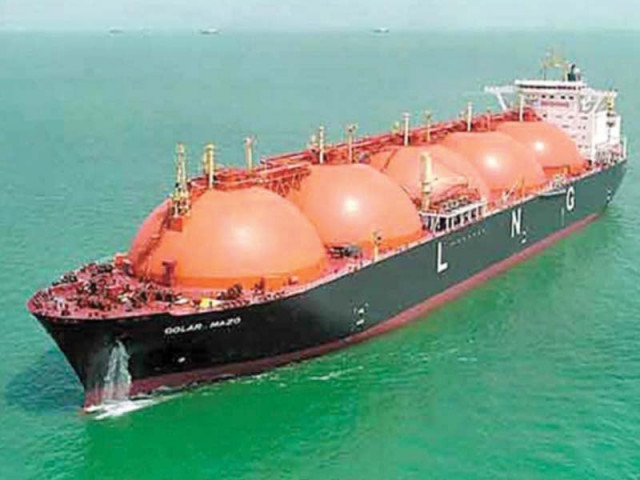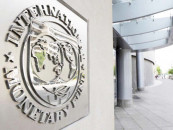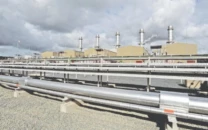Pakistan seeks to renegotiate LNG deal with Qatar
Slow industrial activity, slump in power demand causes surplus cargoes

Pakistan on Tuesday decided to seek renegotiation of its Liquefied Natural Gas (LNG) import deal with Qatar after its industry slowed down and power demand slumped, resulting in over 50 surplus cargoes during the next one-and-half years alone.
The deal, which will expire in 2031, has left the policymakers with two options — either keep shut its 400 mmcfd per day cheaper local gas production facilities along with diversion of expensive surplus gas to subsidised residential use or seek renegotiation of the deal.
The Economic Coordination Committee (ECC) of the cabinet has allowed the Petroleum Division to engage with Qatar to renegotiate the import volumes to minimise diversion of imported gas to residential consumers and import only what is required, according to the people who attended the closed-door ECC meeting.
Petroleum Minister Ali Pervaiz Malik is expected to travel to Qatar, as the Pakistani authorities are not still sure whether Qatar would also be willing to reopen the import volumes, the sources added.
Based on the official assessment, there will be at least 51 surplus cargoes worth $1.2 billion to $1.5 billion from July this year to December 2026, according to the sources.
After assuming office in March this year, Ali Pervaiz Malik has been advocating that either the Power Division fulfil its responsibilities by lifting the promised 600 mmcfd imported gas quota or there will not be any other option but to seek renegotiation.
According to a terse Finance Ministry statement on the matter, "the ECC reviewed the overall gas sector supply situation in the country and directed the Ministry of Petroleum to take effective measures to control losses in the sector and ensure operational efficiency".
The sources said that given the surplus imported expensive gas, the government has three options. Pakistan may ask Qatar to reduce the numbers of monthly cargoes to around 6 to 7 from the existing 9. The second option is that the government may seek an extension in the expiry period with the request to postpone the delivery of the surplus cargoes beyond the original expiry period of 2031.
The sources said that the third option of Non-Performance Damages (NPD) clause is given in the contract under which Qatar can sell gas to the third party and claim losses from Pakistan, if the price of selling the gas is lower than the contract price.
Pakistan is obligated to pay for contracted LNG volumes even if not consumed. The contract allows flexibility to adjust intake by up to three cargoes per year.
The Pakistan-Qatar LNG deal consists of two major agreements signed in 2016 and 2021, aimed at addressing Pakistan's energy needs through long-term LNG supply contracts.
The sources said that Pakistan will get an opening for terminating the deal in 2026, if both the sides do not agree on a new price of the gas. The 2016 deal allows termination after 11 years, which is the year 2027, if price renegotiation fails in 2026. The 2021 deal has a shorter 4-year review period, also starting in 2026, but a fixed end date of 2031 unless renegotiated or terminated early.
The 15-year agreement enables Pakistan to import up to 3.75 million tonnes per annum (MTPA) of LNG to address its energy shortfall. The 2016 deal had been signed at 13.37% of the Brent crude oil price. Each cargo corresponds to roughly 100 million cubic feet per day (MMCFD), totaling 500 MMCFD.
The 2021's 10-year deal, provides up to 3 MTPA of LNG at a lower rate than the 2016 deal. It was signed to replace expiring, costlier contracts and ensure supply security.
The price of the 2021 deal was 10.2% of Brent crude, a 31% reduction compared to the 13.37% rate of the 2016 deal.
Pakistan has already deferred five cargoes from the 2016 deal to 2026 without financial penalties.
Due to sluggish economic growth causing lower electricity demand from the national grid and the overall low demand and highly unaffordable prices, the government was not fully running-the LNG fired power plants, which was one of the reasons for the import of gas.
Due to roughly Rs3,500 per mmbtu imported gas price, the government also cannot divert the gas to households without incurring heavy losses.
LNG was primarily imported to meet the demand of power sector while balance was made available to industry. The LNG Sale Purchase Agreements (SPAs) carried 100% take or pay clause for PSO/PLL whereas instead of mirroring the same clauses, the Gas Supply Agreements (GSAs) with power plants were executed initially at 66% of minimum take-or-pay and later revised to 50% with effect from January this year, the sources added.
Before the commissioning of these LNG based power plants, it was assumed that these plants being most efficient would be placed higher in Economical Merit Order (EMO) and/or to be declared as must-run plants for peak loads which did not happen, they added.
With the passage of time, LNG demand of power sector has reduced substantially due to availability of generation from other sources which has led to issues of surplus LNG in the system. This LNG glut in system has further been exacerbated with drastic decline in LNG consumption by captive power plants owing to imposition of grid transition levy.
The sources said that SNGPL has reported that around 11 cargoes are surplus for July to December 2025 period and similarly for calendar year 2026 some 40 LNG cargoes are estimated to be surplus, considering the projected demand of power sector and demand destruction in the CPPs.
This translates into $1.2 billion to $1.5 billion unnecessary import bill for a country whose almost 100% foreign exchange reserves are based on foreign loans.
The sources said that the SNGPL is constrained to divert expensive RLNG to domestic sector. To deal with issue of surplus LNG, SNGPL resorts to curtailment of gas production form local fields, which ranging between 250 to 400 mmcfd, to maintain the integrity and safety of the system owing to higher line pack pressures.
Curtailment of local production in turn is impacting the revenues of exploration and production companies besides impacting the production of condensate, crude oil and LPG from oil and gas fields, they added. As per the Estimated Revenue Requirements (ERR) for CFY as determined by OGRA, the cost of diversion of RLNG to domestic sector on SNGPL network has been estimated at Rs242 billion against 24 cargoes which led to increase in consumer gas prices, the sources said.
The only option for Pakistan now remains to request the brotherly country to review the deal in the light of these developments, the sources added.





















COMMENTS
Comments are moderated and generally will be posted if they are on-topic and not abusive.
For more information, please see our Comments FAQ